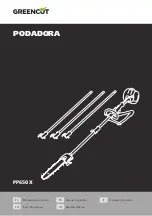
fig. 1
4.3.
Changing the blade
4.3.1. Swing up the blade to full height.
4.3.2.
Remove the guard link screw (fig.3.1) and pivot the link (fig. 3.5) out of the way.
4.3.3. Loosen guard screw (fig. 3.2) and remove second guard screw (fig.3.6). Remove pivoted blade guard (fig. 3.3).
4.3.4. Remove the single retaining screw and slide off the dust deflector (fig. 3.4).
4.3.5. Use the pin spanner to hold the outer blade flange while removing the blade retaining bolt, by turning it clockwise (LH thread), with the
tube spanner. Remove the outer blade flange and then the saw blade with care. Wear hide palm riggers gloves to protect hands from
the blade, which is sharp.
4.3.6. When fitting the new blade it is very important to ensure that the direction arrow on the blade matches the arrow on the blade housing.
Clean shaft and flanges and then fit blade, outer blade flange, washer and bolt. Tighten bolt.
4.3.7. Refit the dust deflector, the pivoted guard and the link. Check the operation of the pivoted guard by lowering and raising the blade.
SM10 - 0016 - (1) - 190601
fig. 2
fig. 3
4.4.
Table insert
p
WARNING!
To reduce the risk of an accident the table insert (fig. 1.13)
must be replaced if it becomes worn or damaged.
4.4.1. Raise the blade.
4.4.2. Remove the five countersunk screws and remove insert.
4.4.3. Fit new insert and retain with the five countersunk screws.
WARNING!
As with all power tools, there are potential hazards involved in the use of this saw. It is, therefore, vital to ensure that you
have read and understood all the safety instructions in Section 1.
Familiarise yourself again with the specific saw safety rules for each step of the following operation. Failure to do so could cause
serious damage and/or personal injury and may invalidate your warranty. Disconnect the saw from the mains power before making
any adjustments or removing/fitting the blade. Ensure that all screws and nuts are secure and that the blade is in good condition and
correctly fitted. ALWAYS wear approved safety eye protection.
5.1.
Set the required table angle and blade angle (paras. 4.1. & 4.2.). Leave blade in raised position.
5.2.
Secure the workpiece against the fence (fig. 1.12) with the clamp (fig. 1.11).
s
DANGER!
If holding the workpiece by hand take extreme care and ensure hand is kept away from the blade.
5.3.
When you have completed the cut, the waste off-cut will either remain on the saw table and workpiece supports or fall off, depending
upon size. Before starting, therefore, consider how you will handle the off-cut.
5.4.
Plug the saw into the mains power supply.
5.5.
Hold the saw handle and squeeze the switch trigger. When the blade has reached maximum speed press the lock lever (fig. 1. 2) and
bring the blade down onto the workpiece.
5.6.
Slowly move the blade down through the workpiece. Do not try to force the blade through the wood, use light pressure.
5.7.
When the cut is complete allow the blade to rise to the upper position and release the switch to turn off the saw.
p
WARNING!
DO NOT
attempt to pick up an off-cut or to remove the clamped workpiece before the saw blade has completely stopped.
5. OPERATING INSTRUCTIONS






















